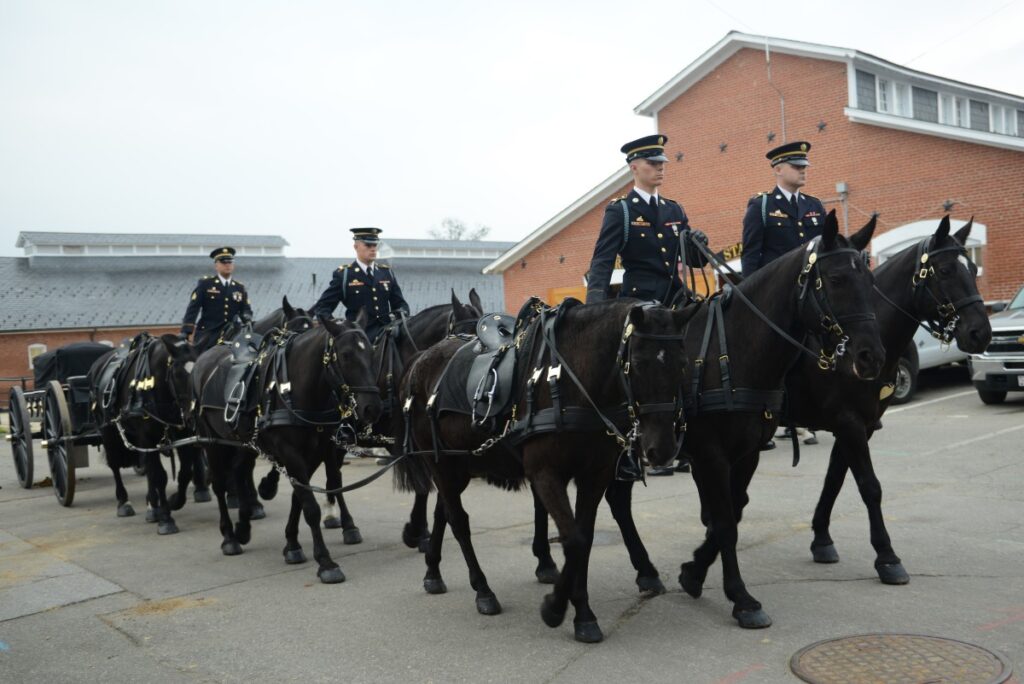
Washington, D.C. – On Wednesday, the Army revealed modifications to the way it will look after the gray and black horses in the ceremonial unit that transport the flag-draped caskets of service members to their final resting places in Arlington National Cemetery. The changes were prompted after the deaths of some horses due to their inadequate living conditions.
The horses belong to the caisson platoon of the 3rd Infantry Regiment, also called the Old Guard. This regiment is popularly known for guarding the Tomb of the Unknown Soldier at the cemetery, situated on the other side of the river from Washington.
In February 2022, Mickey and Tony, two platoon horses from the Old Guard, were euthanized within days of each other due to colon impaction. According to an investigation by the Army, Tony had to be euthanized because the sand and gravel impaction in his case was too extensive to be removed through surgery. The report related to Mickey stated there was a “dry, firm mass of feed, or foreign material, such as dirt or sand,”.
According to the investigation, veterinarians found sediment in the manure of other horses which could be attributed to the small amount of grass available in their turnout fields. The two horses that died were also in their 20s and had likely consumed sand and gravel from the ground while eating hay.
Additionally, the low quality of hay made it difficult for older horses like Tony to digest as they searched for edible feed by nosing it on the ground. Army veterinarians observed this problem half a year before the horses died, but they did not escalate the issue beyond the platoon leadership.
Moreover, the platoon was unable to compel the hay supplier to furnish superior quality hay because the Army contract did not specify the necessary nutritional value.
The investigation revealed that the small turnout fields where horses grazed outdoors were filled with construction debris and manure. Even if these fields were in good condition, they would have been insufficient to support more than six or seven horses. During the time when the horses died, there were 64 of them using the field.
According to Major General Allan Pepin, the commanding general of the Military District of Washington, the poor conditions for the horses were due to mismanagement and not soldier abuse.
Pepin believes that senior leadership did not fully understand the needs of the horses and the required training for soldiers to care for them, as well as a lack of resources.
“The platoon took it personally because nobody wanted this outcome,” Pepin told members of the press on Wednesday. “Every time you went by and saw the missions, we never saw a horse that looked like it was lame. We never saw a horse that looked like it was having issues. What we saw was expert soldiers and horses that looked great. So it kind of masked the underlying problem.”
In the past few months, the Army has taken the initiative to retire some of its older horses, some of which were up to 20 years old and still part of the team that pull the over 2,500-pound caissons dating back to 1918. Additionally, they are in the process of procuring new horses but will steer clear of buying gray horses, which are prone to skin cancer. More pasture land has also been leased, and Congress has provided the necessary funding to upgrade the stables.
According to Pepin, the Army is currently developing a lighter caisson to lessen the burden on horses and creating new saddles and other equipment to prevent horse injuries.
The Army has since hired a full-time herd manager and enhanced the horses’ diets after the euthanizations, and the regular veterinary bloodwork indicates that the horses are making progress.
Unfortunately, two more horses had to be euthanized since then, one because of a leg fracture and the other due to intestinal issues.
The Army also recently suspended caisson operations for 45 days to allow time for the horses to recuperate from any injuries.